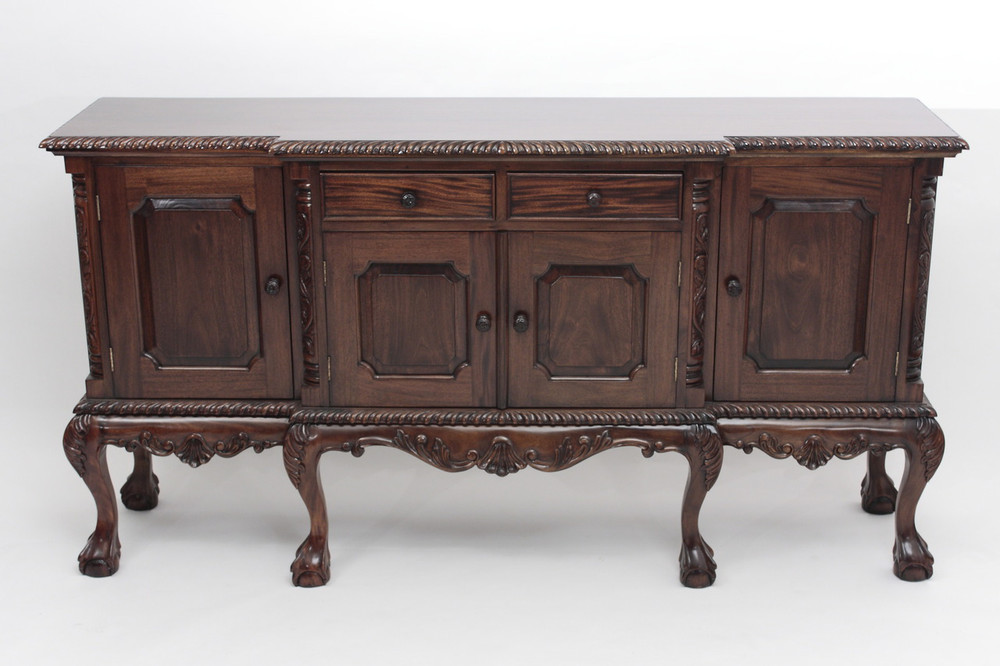- Home
- Learn About Antique Furniture and Reproductions
- Resources
- Sideboard Sizing
Sideboard Sizing
One of the most crucial additions to building an impeccable dining experience for you and your guests is having the extra storage on hand in order to handle any unexpected arrivals or family-gatherings. If you adore the art of entertaining guests often, this is especially important for you to build a beautiful impression.
Adding a functional yet matching repository to both match your bespoke custom dining room table can be a taxing experience. Searching for ideas, matching your unique dining room décor, art as well as personal tastes can often leave you wondering where to begin and what to do.
Once you find the striking match that makes you feel confident in your choice; do you know how it will fit into your dining room plans? How many of your heirloom dishes will it hold? Will it fit well with the dining room table you already own as well as the room itself? Let us guide you to an elegant, easy solution to ensure that your new sideboard will be everything you desire and more to the grandeur of your dining ambiance.
Consider Your Dining Collection
The first step in sizing a sideboard should be to factor in what sort of dinnerware, dishes, glassware or more you may need to have at hand when entertaining. Will you be using it to also display your handed down plates and china, or will it function more as a side piece that accentuates the main element of your room?
One of the best pieces of advice we believe to keep in mind is that you should always focus on a piece that not only will house your current dinnerware, but have room for new pieces, finds and additions in the future as well. If you wish to store your linens with your dinner plates, a little extra room will go a very long way.
Pair it Well with Your Décor
Not only are sideboards excellent for storage, their surfaces can be a magnificent means to display extra food dishes during large gatherings that may not fit on your table, or also a decorative touch for the holiday festivities.
In choosing a sideboard for your dining room, it must pair well with your current furniture in terms of size. Compare the dimensions of your potentially new sideboard with the couture, design, and feel of your dining room table. You can balance these two by picking a sideboard that stands higher to your table but in the same essence of the table's overall look and feel. For instance, a narrow and slim Sheraton sideboard may not pair well with the majestic size of a Chippendale extension dining room table or a French Country dining table.
For grander dining room table sizes, match the sideboard with the same impression your table makes. For the best possible harmony give thought to purchasing furniture from collections to keep the theme of your dining room complete—a Colonial sideboard will always look exquisite alongside a Colonial dining table.
Open or Closed?
When you are creating the formal experience, an open sideboard is an enchantingly airy, open touch. Open sideboards tend to bring to a room a lighter feeling and would fit in well with a lively dining room style. For the dining room owner who entertains daily or with a more formal essence to their room, closed will lend a comparable atmosphere suitable to the wonderful furniture you already have.
Movement
Most traditional home formal dining rooms open from a foyer with a pair of windows, a solid wall opposite the foyer entrance and an entryway to the kitchen. Several professional decorators will agree that you should have the minimum of 18" behind a chair at your dining table so guests may be seated comfortably as well as at least a 28" clear passageway. This is to make sure that you and your family or guests as well as whomever is serving many have plenty of thoroughfare without stumbling over anything.
Sets
When it comes to matching furniture, leaving it to those with decades upon decades of experience is never a negative. Skilled craftsmen will almost always offer furniture pieces available in sets, and will have already taken into consideration exactly how to match and size two pieces within a set.
On Average
If you enjoy more elasticity to your dining room layout and would like to pair two pieces not of the same set, there are some rough general averages most designers agree upon for the size of a sideboard. When looking for your next sideboard or buffet in general terms, a common height is about 36 inches.
Rug Placement
Should you have in mind or already have an area rug, give thought to the fact that your buffet or sideboard generally should not be on a rug.
Lighting
Are you replacing an older sideboard to match a newer dining room table? Or perhaps you are simply switching out another table for the added grace and elegance of an antique reproduction to better match your antique table? Either way, if you already have table lamps, or buffet lamps, how tall they are should also influence what size you purchase. Your lamps should be no more than 1.5 times the height of the sideboard should you be using them on it. If your buffet or table lamp uses a shade remember that it should never be wider than the sideboard top and that the lamp shouldn't sit at the level of eyesight within guests.
If you keep this advice in mind, you should be on your way to picking the right size sideboard for a dining room of your dreams made into reality.










